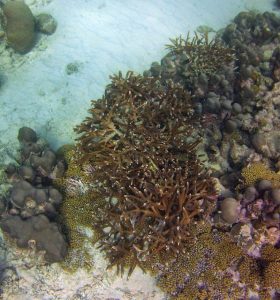See the Subpage: A cervicornis iNaturalist Records
These include A. cervicornis recently dead, likely due to coral bleaching in 2023.
Also view The Acroporoids, and All 3 Acroporpoids occur on Vauxhall Reef

A. cervicornis at about 30 ft depth at Vauxhall reef in the Recreational Zone of the Barbados MPA in 2015
“The staghorn coral (Acropora cervicornis) is a branching, stony coral with cylindrical branches ranging from a few centimetres to over two metres in length and height….The dominant mode of reproduction for staghorn corals is asexual, with new colonies forming when branches break off a colony and reattach to the substrate. This life history trait allows rapid population recovery from physical disturbances such as storms. However, it makes recovery from disease or bleaching episodes (where entire colonies or even entire stands are killed) very difficult.”
When I “discovered” Vauxhall Reef in 2015 I kept an eye out for staghorn coral in Reef Front/Deepwater Communities zones of John Lewis (1960), not out of any thought I might actually see it, but kind out of habit from years earlier as a student at the Bellairs Research Institute where John Lewis was director and out coral reef mentor. Staghorn coral occurred just seaward of the fringing reef at Bellairs Bellairs at 10m+ dpeth, and tested our snorkelling skillsforst to spot it and then to to grab a piece which we would bleach and take hime – there was no taboo on such practices in those days.
To my astonishement, I actually spotted some staghorn coral in similar habitat at Vauxhall in early March of 2015. Later l learned that it was essentially still unknown in Barbados following its demise in the late 70s/early 80s due to White Band Disease; McLean & Oxenford (2016) observed no stands of A cervicornis in a survey of Acroporoids on fringing reefs the west coast of Barbados, but cited my 2015 report of its occurrence at Vauxhall. In fairly extensive snorkelling along most of the Barbados MPA to approx 10 m depth subsequently 2015-2024, I have viewed no other stands.
For more details, view the subpage: A cervicornis iNaturalist Records
